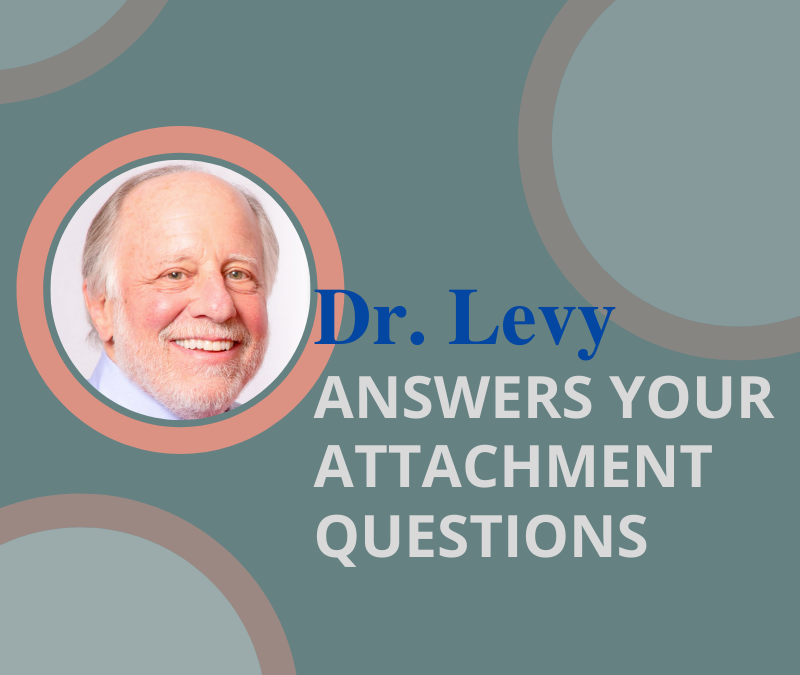Each month, Dr. Levy answers a common question he has received from professionals, caregivers and parents during three decades of pioneering work on attachment theory, treatment and training.
A lack of secure attachment in the early stages of development combined with abuse, neglect and multiple moves, commonly results in a number of problems, symptoms and conditions. Among these are Oppositional Defiant Disorder (ODD), conduct disorder, Attention Deficit/Hyperactivity Disorder (ADHD), major depression and dysthymic depression, bipolar disorder and Posttraumatic Stress Disorder (PTSD).
ODD
All parents know about the “terrible 2s” – the time when young children assert their independence and autonomy through oppositional behavior (e.g. saying “No” to parental requests and having temper tantrums when they don’t get their way.) Children with compromised attachment never grow out of this stage of development. They are defiant and hostile toward parents and other authority figures because of their lack of trust and need to control.
This is typically diagnosed as ODD when defiant, negative and hostile behaviors last at least six months.
Conduct Disorder
Conduct disorder is the next step up in severity of harmful behavior from ODD, and includes behaviors that violate the basic rights of others and oppose the rules of society including abusive, violent or criminal behavior. These children and adolescents are showing true signs of antisocial personality, often a result of severe maltreatment and compromised attachment.
ADHD
ADHD is a neurologically-based disorder that is present in about 5% to 10% of school-age children. About half grow out of it by adolescence, while for the remainder it continues into adulthood. ADHD is characterized by hyperactivity, inattention and impulsivity. Children with compromised attachment are often misdiagnosed with ADHD, due to similarity of symptoms.
Symptoms
Inattention includes being easily distracted, making careless mistakes, not listening when spoken to directly, not following through on instructions, failing to finish homework or chores, etc.
Hyperactivity includes fidgeting and squirming, having a hard time sitting still or staying quiet.
Impulsivity includes blurting out answers, interrupting others or blurting out answers.
Major Depression
Mood disorders in children are classified as major depression, dysthymia (less severe depression) and bipolar disorder. Depression in children is often overlooked and not diagnosed because the symptoms include irritability, fatigue and lack of concentration. Depression can be genetic; between 30% and 50% of children with depression have a family member who also has depression. Depression is associated with grief and loss and therefore is almost always present in children with compromised attachment.
Symptoms
- Irritability
- Diminished interest and lack of enjoyment and pleasure in activities
- Too little or too much sleep
- Lack of or increased appetite; significant weight loss or gain
- Slow movements and speech
- Poor concentration and indecisiveness
- Fatigue or lack of energy
- Feelings of worthlessness and excessive guilt
- Suicidal thoughts and behaviors
Dysthymic Disorder (Depression)
Dysthymic disorder is a low-grade, long-term form of depression that is the most common mood disorder in children and teenagers. It includes many of the symptoms of major depression, but to a lesser degree most of the day for at least two years. This ongoing depression is very common among children who have a history of maltreatment, unresolved loss and grief and compromised attachment.
Bipolar Disorder
Bipolar disorder is characterized by mood cycles or swings between depression and mania. During depression, the child experiences the common symptoms of depression – sadness, irritability, fatigue, etc. During a manic period, they become impulsive, very talkative, go without sleep, feel invisible and engage in high-risk behaviors. About 1% of teenagers have bipolar disorder. There is a significant overlap between the symptoms of ADHD and bipolar disorder, which makes diagnosis more challenging. Children who have both ADHD symptoms and bipolar symptoms have more severe behaviors and are more impaired psychosocially.
PTSD
PTSD is one of the most serious anxiety disorders and is common in children and teens with histories of severely compromised attachment, abuse and neglect. PTSD develops after a child experiences very stressful and frightening events such as physical or sexual abuse or is a victim or witness to violent events or disasters
During the trauma, the child feels intense fear, helplessness and horror. These reactions are normal and are part of the fight-flight-freeze response in the brain’s limbic system. When these symptoms are not processed and the child, or an adult, lives in a constant state of arousal for one to three months or longer, then the more severe and long-term disorder develops.
There are four primary symptom categories of PTSD: 1. Re-experiencing the trauma through flashbacks, nightmares or painful memories. 2. Numbing of responsiveness and avoidance of reminders of trauma including dissociation. This can range from avoiding people and activities that trigger painful memories, and detaching from others to substance use, self-harm and engaging in high-risk behaviors to numb feelings. 3. Experiencing hyperarousal which involves impulsiveness, agitation hyperactivity and hypervigilance. 4. Experiencing physical complaints such as frequent illness, eating disorders or pain and weakness issues.
There are numerous symptoms of PTSD and the disorder is highly individualized. In children and teens with histories of compromised attachment, abuse and neglect, PTSD often severely impairs normal functioning. Parents are at a loss and overwhelmed. Understanding the mental defenses that can often manifest in physical symptoms can greatly help parents and caregivers respond to their child’s needs.
Understanding the possible mental health issues that often coexist with an attachment disorder, and their symptoms, can go a long way to alleviating some of the frustrations felt by parents or caregivers and help facilitate healing and attachment.
Previous articles addressed questions about the Seven Functions of Secure Attachment, the Dependency Paradox, the importance of talking about trauma, the First Year Attachment Cycle, traits of successful and healthy adult relationships, the importance of hope as a part of treatment for trauma, the core concepts of child development, parenting strategies for deescalating conflict and the importance of touch to fostering attachment.


